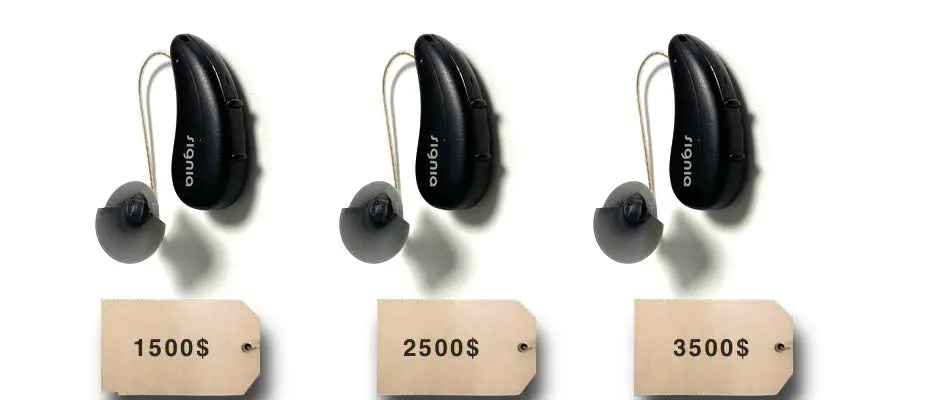If you wonder what the qualitative differences in hearing aids are this article is for you. In this article, you will learn what components drive quality in hearing aids and why manufacturers may provide a very similar quality in all there hearing aids.

First of all, as you can see in the picture above there are three hearing aids shown. All look exactly the same but the price tags are very different. Hearing aids basically consist of microphones (1 up to 3) a processor and a loudspeaker that is placed in your ear. Some of them are powered by a replaceable battery and others have rechargeable batteries. The quality of hearing aids is an ensemble of those components.
But it does not matter if you buy lower priced model or a high end variants. The quality of the loudspeaker is exactly the same. Usually hearing aid manufactures try to make two to three options of loudspeakers which all can be clicked into the same ports.
The same is true for the microphones or the processor. The components are the same but the software enables the full capability of the hardware. This means microphones from the left hearing aid communicate with the hearing aid in the right ear to reduce noise best and amplify speech at the same time.
The software makes the difference. In terms of the hardware, practically all electronic components are the same. The question is can you hear the suppression of noise of the things you do not want to hear. Do you value a Bluetooth connection to enable a feature in your hearing aids that make your daily routine easier?
But Do Those Qualitative Differences in Hearing Aids Make a Difference to You?
It is dependent on your lifestyle and what features you really need. I fit hearing aids daily and the outcomes are very different. During a hearing aid fitting, the professional can not tell if a high-end premium hearing aid will definitely outperform cheaper alternatives. In some cases, people experience this. But as studies show the qualitative differences between them may not be as relevant as this study says.
In this study, the effectiveness of advanced hearing aids with noise reduction technologies for older adults with mild to moderate hearing loss was tested. And the quality was not there in real life. Here is an excerpt of the study.
Although premium DM/NR features and premium HAs outperformed their basic-level counterparts in well-controlled laboratory test conditions, the benefits were not observed in the real world.
The current study suggests that although both premium and basic DM/NR technologies evaluated in the study have the potential to improve HA outcomes, older adults with mild-to-moderate hearing loss are unlikely to perceive the additional benefits provided by the premium DM/NR features in their daily lives.
Study by YU-Hsiang Wu and Elizabeth Stangl et al.
That news does not speak for the best products in the hearing aid industry. So is it all made up? Do premium hearing aids benefit from the placebo effect? But some people really choose premium hearing aids. While some of those buying decisions are related to the effects of marketing some people experience a qualitative difference between high-end hearing aids and their less price-intense counterparts.
You can find out of you experience qualitative differences when you try out different technology levels. The more features a technology levels includes the higher the price for the hearing aid will be.
When customers are unsure of what to choose it is possible to fit them with two pairs of hearing aids. This has the big benefit of being able as a consumer in the trial to switch in the same situation between the less and more price intense models. When you hear a qualitative difference you can decide if it is worth the price. If you hear no difference just go with the cheaper one.
Most of the hearing aids will have very similar standards in terms of built quality. A lot of them have IP68 ratings which still does not mean you can take them in the shower. The loudspeakers for example have also all very similar performances.
For you, as a potential buyer of hearing aids, it is far more important to find a hearing care professional who really takes the time to go through all the important measurements (best practices) and explain to you what options you have individually. This will make the biggest difference in your experience with a hearing aid.
When you listen to the marketing noise around hearing aids you can be easily misguided into thinking you must hear everything with more expensive hearing aids. But as you can see in the video above the quality of hearing is rather close. Some people prefer a certain technology level and this level can be even found in the middle of the options or the cheaper end.
In this article was a lot of information about what to expect when it comes to the quality of hearing aids. There is no brand other where I have not seen any defects. Most of them can be easily repaired. I highly recommend not read too much about hearing aids but rather you try them. Gather experience and then you will realize things that bothered you during the trial period and other things that might be very positive. But this experience is very subjective.
I wish you a great day.
